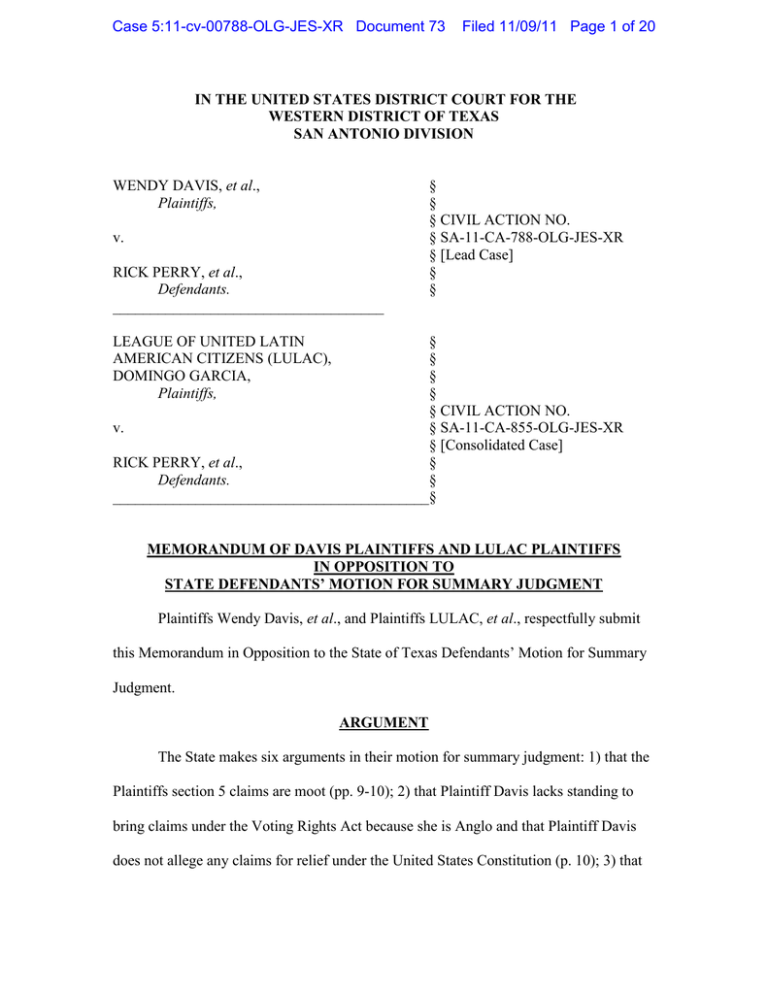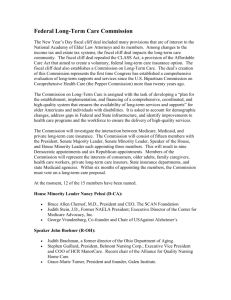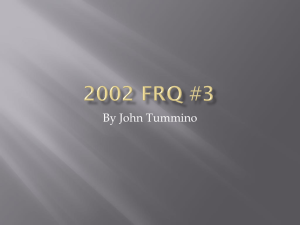Case 5:11-cv-00788-OLG-JES-XR Document 73 Filed...
advertisement

Case 5:11-cv-00788-OLG-JES-XR Document 73 Filed 11/09/11 Page 1 of 20 IN THE UNITED STATES DISTRICT COURT FOR THE WESTERN DISTRICT OF TEXAS SAN ANTONIO DIVISION WENDY DAVIS, et al., Plaintiffs, v. RICK PERRY, et al., Defendants. ____________________________________ § § § CIVIL ACTION NO. § SA-11-CA-788-OLG-JES-XR § [Lead Case] § § LEAGUE OF UNITED LATIN AMERICAN CITIZENS (LULAC), DOMINGO GARCIA, Plaintiffs, § § § § § CIVIL ACTION NO. v. § SA-11-CA-855-OLG-JES-XR § [Consolidated Case] RICK PERRY, et al., § Defendants. § __________________________________________§ MEMORANDUM OF DAVIS PLAINTIFFS AND LULAC PLAINTIFFS IN OPPOSITION TO STATE DEFENDANTS’ MOTION FOR SUMMARY JUDGMENT Plaintiffs Wendy Davis, et al., and Plaintiffs LULAC, et al., respectfully submit this Memorandum in Opposition to the State of Texas Defendants’ Motion for Summary Judgment. ARGUMENT The State makes six arguments in their motion for summary judgment: 1) that the Plaintiffs section 5 claims are moot (pp. 9-10); 2) that Plaintiff Davis lacks standing to bring claims under the Voting Rights Act because she is Anglo and that Plaintiff Davis does not allege any claims for relief under the United States Constitution (p. 10); 3) that Case 5:11-cv-00788-OLG-JES-XR Document 73 Filed 11/09/11 Page 2 of 20 the Plaintiffs’ vote dilution claims “lack merit” and are not supported by “competent summary judgment evidence” (p. 10); ( 4) that Plaintiffs’ claims under the Privileges and Immunities Clause Fail as a Matter of Law (p. 9); 5) that Plaintiffs’ claims of intentional discrimination lack merit because politics, not race, drove the redistricting process (pp. 12-17); and 6) Section 2 of the Voting Rights Act does not compel the creation of minority coalition districts (pp. 17-20). We address each of these claims below, but before doing so, set forth the general parameters of the law governing motions for summary judgment. Under Rule 56(c), Federal Rules of Civil Procedure, summary judgment is proper “if the pleadings, depositions, answers to interrogatories, and admissions on file, together with the affidavits, if any, show that there is no genuine issue as to any material fact and that the moving party is entitled to a judgment as a matter of law.” The party seeking a summary judgment must present the court with “the basis for its motion, …identifying those portions of ‘the pleadings, depositions, answers to interrogatories, and admissions on file, together with the affidavits, if any,’ which it believes demonstrate the absence of a genuine issue of material fact.” Celotex Corp. v. Catrett, 477 U.S. 317, 326 (1986). In considering a motion for summary judgment, this Court must “construe all facts and inferences in the light most favorable to the nonmoving party.” Dillon v. Rogers, 596 F.3d 260, 266 (5th Cir. 2010) (citation and internal quotation marks omitted). See also Aucoin v. Haney, 306 F.3d 268, 271 (5th Cir. 2002). Because the State has failed to produce a record on which this Court may conclude that there is no genuine issue as to a material fact in dispute on the fact bound issues of racially discriminatory 2 Case 5:11-cv-00788-OLG-JES-XR Document 73 Filed 11/09/11 Page 3 of 20 purpose and effect, the State’s motion for summary judgment must be denied. We detail the material facts in dispute in Appendix I, attached hereto. 1) Plaintiffs Claims Under Section 5 of the VRA Are Not Moot It is undisputed that the State’s proposed senate map (S148) has not been precleared by the District of Columbia court. Indeed, that court, by order entered on November 8, 2011, denied the State of Texas’ motion for summary judgment with respect to the state senate plan, as well as the congressional and House plans. See Exhibit 33.1 Moreover, the State has not contested the fact that the benchmark senate plan (S100) is unconstitutionally malapportioned. See Defendants’ Amended Answer at ¶¶ 11-20, pp. 2-4. It is now clear that there will not be any preclearance of the state senate plan in time for the 2012 election cycle, and this Court is now left with the “unwelcomed obligation” to do so. Connor v. Finch, 431 U.S. 407, 414-415 (1977). Thus, the argument made in the State’s motion for summary judgment that the plaintiffs’ Section 5 claims in this case are “moot” because they submitted the proposed senate plan to the DC Court and DOJ did not oppose preclearance, is simply wrong. The DC Court’s order makes clear that the status of the proposed state senate map is in precisely the same category as the state’s proposed congressional and state house plans: none has been precleared, and summary judgment has been denied to all three plans in the DC Court. As far as preclearance is concerned, it matters not at all that the Department of Justice filed an Answer in which it indicated that it would not in the context of the litigation oppose preclearance of the state senate plan. Under Georgia v. Ashcroft, 539 1 Attached to this motion and file simultaneously with this Memorandum, in addition to the Statement of Material Facts in Dispute (Appendix I), are exhibits referenced in this Memorandum and the attached Statement of Material Facts. 3 Case 5:11-cv-00788-OLG-JES-XR Document 73 Filed 11/09/11 Page 4 of 20 U.S. 461 (2003), those groups of Defendant-intervenors in the DC Court who oppose preclearance of the state senate plan are entitled to present their case to that court irrespective of the position of the United States in that litigation.2 Indeed, in Georgia v. Ashcroft, supra, the Supreme Court expressly upheld the rights of intervenors in preclearance cases to raise claims and issues beyond those being advanced by the United States. The Court expressly rejected in Georgia v. Ashcroft the same unfounded claim made here by the State of Texas: “that private parties should not be allowed to intervene in §5 actions because States should not be subjected to the political stratagems of intervenors.” The Davis and LULAC Intervenors have not intervened in the DC case as part of any political strategy; rather we have intervened to protect and defend the rights of minority voters in Senate District 10 in that preclearance action.3 The State’s claim that the Plaintiffs’ Section 5 claims are moot is strange. The State has already admitted in their Amended Answer [#38] that the proposed senate map is not legally enforceable until Section 5 preclearance is obtained (¶29), and further admitted that the state senate map has not been precleared (¶2). Those admissions in their Amended Answer are inconsistent now with their position that by merely making a preclearance submission of the plan to the DC Court, they have fulfilled their Section 5 obligations. If anything, Plaintiffs’ Section 5 claims are more ripe than ever for this Court to adjudicate: the proposed state senate plan (Plan S148) is legally unenforceable because it has not been precleared under Section 5 of the Voting Rights Act, and a new interim plan 2 In the DC preclearance litigation, the following groups of intervenors oppose preclearance of the state senate plan: Davis intervenors, LULAC, NAACP, and the Texas Legislative Black Caucus. 3 The Davis and LULAC Plaintiffs here have also intervened in the DC litigation to oppose preclearance of the State’s congressional plan. 4 Case 5:11-cv-00788-OLG-JES-XR Document 73 Filed 11/09/11 Page 5 of 20 must be imposed by this Court to remedy the admitted malapportionment of the benchmark map. 2) Plaintiff Davis Has Standing To Bring Claims Under The Voting Rights Act And States Claims Under The Constitution. The Defendants’ motion for summary judgment also claims that because Davis is Anglo, she cannot bring claims under the Voting Rights Act. First, it is worth noting that the State’s argument that whites are not protected by the Voting Rights Act is directly contrary to Fifth Circuit precedent, which has held that Section 2 of the Voting Rights Act was violated in that case because “Defendants, through abusing their supervisory role over the absentee-ballot process, have denied white Democrats the opportunity to elect representatives of their choice.” United States v. Ike Brown, 551 F. 3rd 420 (5th Cir. 2009). Second, Plaintiff Davis, like all of the other Plaintiffs in these consolidated cases, brings cognizable claims under the United States Constitution. Plaintiffs allege the current plan is malapportioned in violation of the United States Constitution. Defendants, in their Amended Answer do not contest that the statistical malapportionment exceeds constitutional limits. Plaintiff Davis has standing to bring this claim regardless of her race.4 Third, Defendants mistakenly believe that this case is about Senator Davis’ right to hold office. It is not. This is a case designed to protect the voting rights of Texas voters and particularly those voters in Senate District 10. Senator Davis is the elected representative of those persons and also a voter within the district she represents. Plaintiff Davis is injured by the State’s proposed plan in the same way as her constituents and the communities of interest within Senate District 10. 4 Plaintiffs Davis and other Plaintiffs have submitted sworn Declarations attesting to their voting status and their senate district of residence, thus establishing they reside in overpopulated districts and have standing to bring one-person one-vote claims set forth in Plaintiffs’ complaints. See Exhibit 32. 5 Case 5:11-cv-00788-OLG-JES-XR Document 73 Filed 11/09/11 Page 6 of 20 Finally, we would note that even if it were true that Senator Davis lacked standing (which she does not), the Supreme Court has made clear that as long as some of the plaintiffs have standing, this Court should consider all of the Plaintiffs’ claims. See Massachusetts v. EPA, 127 S Ct 1438 at 1453-54 (2007) (“Only one of the petitioners needs to have standing to permit us to consider the petition for review”, citing Rumsfeld v. Forum for Academic and Institutional Rights, Inc., 547 U.S. 47, 52, n. 2, 126 S.Ct. 1297, 164 L.Ed.2d 156 (2006)). For all these reasons, sworn Declarations show that Davis and other Plaintiffs reside in overpopulated districts and have standing to bring this action. No contrary evidence has been offered by the State. Thus, the argument that Plaintiff Davis lacks standing is without any merit. 3) Plaintiffs’ Section 2 Vote Dilution Claims Are Meritorious The State contends that the Plaintiffs’ Section 2 vote dilution claims are not based on “competent summary judgment evidence” and therefore lack merit. The State is simply wrong, and in any event, their arguments actually establish that there are genuine issues of material fact in dispute regarding the Section 2 claims. On that basis alone, a denial of the State’s motion for summary judgment is warranted. As detailed in Appendix I (Statement of Material Facts in Dispute), Senate District 10 (SD 10) over the course of the last decade grew into an effective opportunity district for a coalition of minority voters. By 2008, black and Hispanic leaders knew that the district provided an effective opportunity to elect their preferred candidate and they recruited a viable candidate to run (Wendy Davis). As one Hispanic leader in Fort Worth put it: “Over the course of the decade, Hispanic and African American leaders in Tarrant County had paid close attention to the rapid growth of the minority 6 Case 5:11-cv-00788-OLG-JES-XR Document 73 Filed 11/09/11 Page 7 of 20 population within the boundaries of Senate District 10. As the 2008 election approached, we understood that the minority community had become sufficiently large and united to form an effective coalition to elect our candidate of choice.” Exhibit 1, Declaration of Sergio DeLeon. In the 2008 election, Hispanic voters and black voters gave near unanimous support to Davis (in the 99% - 100 % range), while Anglos gave only an estimated 30% of their votes to Davis. See Dr. Lichtman Report at Exhibit 7.5 Davis, the clear and overwhelming choice of minority voters, was elected by the minority voter coalition. The State has made much of the claim that reconstituted statewide election returns do not show SD 10 to be an effective district for minority voters. But those statewide returns are not the best evidence of the minority voter coalition that elected Davis in 2008. Those who formed the minority coalition behind Senator Wendy Davis’ 2008 election knew that, since 2008 was a Presidential election year, they needed to target their scarce resources in SD 10, even if it meant that they would have to withhold their financial support and other resources from statewide campaigns. Organizational and financial support was committed to the election of Wendy Davis to the near exclusion of statewide candidates, including our Presidential candidate, Barack Obama and our US Senate candidate Rick Noriega [an Hispanic]. As minority community leaders, we understood that diverting resources to statewide candidates would harm rather than enhance our opportunity to elect our candidate of choice in Senate District 10. Exhibit 3, Sergio DeLeon Declaration. See also Exhibit 6, Boyd Richie Declaration. 5 Exhibit 7, Dr. Lichtman Report at 2-3. “Anglo voters strongly bloc voted against the candidates of choice of Latino and African American voters.” Ibid. Dr. Lichtman found that “Senator Davis was an overwhelming consensus choice of Latino and African American voters in the 2008 SD 10 election, and that Senator Davis was elected by a unified coalition of Latino and African American voters.” Id., at 3. 7 Case 5:11-cv-00788-OLG-JES-XR Document 73 Filed 11/09/11 Page 8 of 20 By the time of the 2010 census, Senate District 10 had become a majorityminority district in terms of total population. Ex. 2. SD 10, according to the 2010 census, was 52.4% combined Hispanic, Black and other minorities. Ibid. Even the state senate’s map drawer not only was able to identify minority neighborhoods in SD 10 as communities of interest, he was able to identify their racial/ethnic composition: “Southeast Fort Worth, Everman and Forest Hills are the three historically predominantly African American neighborhoods in Fort Worth.” Ex. 9 at page 33. He described the community of interest in SD around the stockyard area of North Forth worth as “highly Latino.” Ex. 9 at 33. As the above facts show, there is powerful, credible, and overwhelming evidence that Senate District 10 developed over time into a minority coalition district comprised of communities of interest that shared particularized needs and concerns. That coalition was destroyed by S148 and the voting strength of minority voters was diluted as a result. The state is free, of course, to contest those facts, but at a minimum, there are genuine issues of material fact in dispute and, accordingly, the State of Texas’ motion for summary judgment on the Section 2 claims of racial vote dilution should be denied. 4) Plaintiffs’ Claims Under the Privileges and Immunities Clause As Plaintiffs have explained in their Response in Opposition to the State’s Motion to Dismiss, this Court need not reach the Privileges and Immunities claims in this case. We do not repeat those arguments here but incorporate them by reference. In addition, it has been admitted that the current benchmark plan (S100) is malapportioned in violation of the Fourteenth Amendment. Plaintiffs are denied equal protection of the laws as a result of that malapportionment because they live in overpopulated senate districts. This 8 Case 5:11-cv-00788-OLG-JES-XR Document 73 Filed 11/09/11 Page 9 of 20 court can remedy that malapportionment in its interim map and need not decide the Privileges and Immunities claims. 5) Plaintiffs’ Claims of Intentional Discrimination Are Meritorious The State of Texas is free to contest the evidence proffered by Plaintiffs here that Texas engaged in intentional discrimination in the enactment of proposed senate plan S148. But the State should do so at trial because there are material facts in dispute. The racially discriminatory purpose underlying Plan S148, as well as the diminution of the minority community’s ability to elect their preferred candidate and participate effectively in the political process, are material facts because they ultimately are determinative of the issues in this action. Anderson v. Liberty Lobby, Inc., 477 U.S. 242, 247-48 (1986). Moreover, in deciding a motion for summary judgment, the Court simply cannot make credibility determinations, or properly weigh the evidence, or draw reasonable inferences from the facts, particularly where there are facts in dispute that are central to the disposition of the case. For that reason, in a motion for summary judgment, “evidence of the non-movant is to be believed, and all justifiable inferences are to be drawn in [its] favor.” Anderson, 477 U.S. at 255. Thus, these genuine issues of material fact are deserving of a trial and the State’s motion for summary judgment should be denied. In Village of Arlington Heights v. Metropolitan Housing Authority, 429 U.S. 252, 268 (1977), the United States Supreme Court set out a framework for determining whether racially discriminatory intent exists. Citing the Arlington Heights case, the Department of Justice has listed the following factors that should be reviewed in assessing whether racially discriminatory intent is present: (1) The impact of the decision; (2) the historical background of the decision, particularly if it reveals a series 9 Case 5:11-cv-00788-OLG-JES-XR Document 73 Filed 11/09/11 Page 10 of 20 of decisions undertaken with discriminatory intent; (3) the sequence of events leading up to the decision; (4) whether the challenged decision departs, either procedurally or substantively, from the normal practice; and (5) contemporaneous statements and viewpoints held by the decision-makers. Village of Arlington Heights, supra, at 266–68. In the case before this Court, there is strong evidence that all of the Arlington Heights factors are present. The Supreme Court has cautioned that determining racially discriminatory intent “demands a sensitive inquiry into such circumstantial and direct evidence of intent as may be available.” Arlington Heights, surpra at 266. The Supreme Court has cautioned that where allegations of racially discriminatory purpose are present, summary judgment is “rarely granted”. Hunt v. Cromartie, Because the fact bound issue of racially discriminatory intent and effect could affect the outcome of this case, the facts in dispute are material and summary judgment is inappropriate. Anderson v. Liberty Lobby, Inc., 477 U.S. 242, 247-48 (1986). As we show below, these disputed issues of racially discriminatory intent deserve a trial. With these legal principles in mind, we proceed in the following pages to summarize the evidence of racially discriminatory intent applying the Arlington Heights, supra, factors. A. The Impact Of The State’s Senate Redistricting Plan As explained above, there is abundant evidence of the racially discriminatory impact of the decision to dismantle SD 10’s minority voter coalition. Dr. Lichtman has provided an expert report noting that the politically cohesive minority community in SD 10 previously elected its preferred candidate to the State Senate in 2010. Dr. Lichtman’s report notes, as do sworn Declarations of several local minority leaders in Fort Worth, 10 Case 5:11-cv-00788-OLG-JES-XR Document 73 Filed 11/09/11 Page 11 of 20 that the effectiveness of the minority voter coalition has been taken away under the State’s proposal. The State of Texas has apparently taken the position that the effective minority voter coalition in SD 10 can be destroyed because neither blacks nor Hispanics separately constituted over 50% of the voting age population in the district. This position finds no support in the case law. Nothing in Section 5 or the cases interpreting Section 5 over the years states that the only districts worth protecting against retrogression are those that reach a certain percentage. As DOJ’s own redistricting guidance correctly states: In determining whether the ability to elect exists in the benchmark plan and whether it continues in the proposed plan, the Attorney General does not rely on any predetermined or fixed demographic percentages at any point in the assessment. Rather, in the Department’s view, this determination requires a functional analysis of the electoral behavior within the particular jurisdiction or election district. As noted above, census data alone may not provide sufficient indicia of electoral behavior to make the requisite determination. Circumstances, such as differing rates of electoral participation within discrete portions of a population, may impact on the ability of voters to elect candidates of choice, even if the overall demographic data show no significant change. See http://www.justice.gov/crt/about/vot/sec_5/sec5guidance2011.pdf (emphasis added). As noted above, there is undisputed evidence that the minority community in Tarrant County had grown throughout the last decade and that, as the State had predicted in 2001, SD would provide a cohesive group of minority voters a realistic chance to elect their preferred candidate to office. See Appendix I at pp.2-3. There is also uncontradicted evidence that the minority communities in SD 10 came together in the middle of the last decade and devised a strategy for electing a candidate to the state senate. They did so by working in tandem with state political party officials to target the SD 10 election. As the State Party Chair observed, he made the “hard choice” “to devote “time, effort and resources to the Senate District 10 race, knowing it would draw 11 Case 5:11-cv-00788-OLG-JES-XR Document 73 Filed 11/09/11 Page 12 of 20 resources away from efforts to elect statewide Democratic candidates or to advance the Obama Presidential campaign.” Ex. 6, at p. 2. The decision to target SD 10 was a “conscious, pragmatic” one, because “Democratic statewide candidates, particularly when they have limited financial resources like Texas statewide candidates did in 2008, do not devote resources to Tarrant County.” Ibid. Thus, Dr. Alford, and likely the United States when it reviewed this matter and decided not to oppose preclearance (under cramped time constraints, we would note) were likely unaware of these uniquely local circumstances that enabled the minority community to elect its candidate of choice in the 2008 election. For this reason alone, the report of the State’s expert Dr. John Alford, is beside the point and, in any event, is contradicted by the evidence of those persons who actually participated in the SD 10 election. Dr. Alford simply took statewide election returns and reconstituted those returns into SD 20 to see how minority candidates running statewide fared in SD 10. As several witnesses have explained, reconstituted election returns from statewide races or any other election contest is an inaccurate measure of voting power in SD 10 because such elections fail to take into account the unique political dynamics within SD 10 that led to minority voters electing their preferred candidate of choice in 2008. See Appendix I at pp. 4-7 and 16-18. Here again, whether SD 10 was an effective minority opportunity district is a genuine issue of material fact in dispute that warrants a trial. There is also uncontradicted evidence that the minority community in SD 10 has been “sliced and diced” and reassigned to new senate districts where they will have no effective ability to participate in the political process. Indeed a large segment of the 12 Case 5:11-cv-00788-OLG-JES-XR Document 73 Filed 11/09/11 Page 13 of 20 minority population in SD 10 has been reassigned to other senate districts where incumbent senators have been unresponsive to their particularized needs (see Ex. 8) or, in the case of Senator Birdwell, outright hostile to the interests of minority voters. See pp. Appendix I at pp. 19-21. In Johnson v. DeGrandy, 512 U.S. 997 (1994), a redistricting case from Florida, Justice Souter writing for the Court noted that “[m]inority voters are not immune from the obligation to pull, haul, and trade to find common political ground, the virtue of which is not to be slighted in applying a statute meant to hasten the waning of racism in American politics.” Over a two year period, from 2006 to 2008, minority voters and leaders in SD 10 strategically planned how to best utilize their growing numbers to elect their candidate of choice. Minority voters fulfilled the obligation to “pull, haul, and trade” in 2008 in Senate District 10. But in the span of just 11 legislative days in May 2011, the State of Texas destroyed their ability to form a coalition and elect their preferred candidate to office by splintering minority communities into several districts. Such a discriminatory, retrogressive result “provide[s] an important starting point” in deciding whether the State’s senate plan is the product of intentional discrimination. Arlington Heights, supra, 429 U.S. at 266. (B) The Historical Background Of The Decision, Particularly If It Reveals A Series Of Decisions Undertaken With Discriminatory Intent. Texas has a long history of racial discrimination in voting. That is the reason the State is subject to the preclearance requirements of Section 5. As part of the 1975 amendments to the Voting Rights Act, Congress extended the Act’s strong protections to cover language minorities. As the Supreme Court observed in Briscoe v. Bell, 432 U.S. 404, (1977), a case in which Texas challenged the application of the Voting Rights Act to 13 Case 5:11-cv-00788-OLG-JES-XR Document 73 Filed 11/09/11 Page 14 of 20 it: “Congress concluded after extensive hearings that there was ‘overwhelming evidence’ showing ‘the ingenuity and prevalence of discriminatory practices that have been used to dilute the voting strength and otherwise affect the rights of language minorities.” Briscoe v. Bell, supra, 432 U.S. at 405-406(footnote omitted). The Court further observed in Briscoe, supra, that Congress, in amending the Voting Rights Act in 1975 “ was particularly concerned “over the plight of Mexican-American citizens in Texas, a State that had not been covered by the 1965 Act.” Id., at 406. In the last five decades of redistricting, the State of Texas has been dragged into federal court every cycle and found to have violated the constitutional rights of Texas voters or violated minority voting rights under the Voting Rights Act. See, e.g., White v. Regester, 412 U.S. 755 (1973); White v. Weiser, 412 U.S. 783 (1973); Upham v. Seamon, 456 U.S. 37 (1982); Terrazas v. Slagle, 789 F. Supp. 828 (W.D.Tex. 1991), aff'd sub nom. Richards v. Terrazas, 505 U.S. 1214, 112 S. Ct. (1992) (mem.) and Slagle v. Terrazas, 506 U.S. 801, 113 S. Ct. (1992) (mem.)); Vera v. Bush, 517 U.S. 952 (1996); and LULAC v. Perry, 548 U.S. 399 (2006). The State’s recurring violations of the Constitution and the Voting Rights Act, particularly in the areas of voting rights and redistricting, provide strong circumstantial evidence that its post-2010 redistricting cycle is once again infected with purposeful discrimination. (C) The Sequence Of Events Leading Up To The Decision. As the facts set forth in Appendix I show, see pp. 9-16, the series of events that led up to enactment of the plan reflected a situation where legislators representing minority opportunity districts were kept in the dark about redistricting and the possible 14 Case 5:11-cv-00788-OLG-JES-XR Document 73 Filed 11/09/11 Page 15 of 20 reconfiguration of their own districts, while Anglo legislators had total access to legislative leaders. In at least four senate districts, it appears Anglo Senators got to draw or design their own districts. See Exhibit 9 at p. and Ex. 8 at ¶15. Senators representing majority minority districts, on the other hand, were shut out of the process and many of them, veterans of redistricting, found that the process leading up to the enactment of the redistricting plan was the worst, most exclusionary, and discriminatory process that they had ever experienced. For example, State Senator Judith Zaffirini, who has served on the senate redistricting committee in the past three redistricting cycles, has provided a sworn Declaration that “[e]ven as a member of the Redistricting Committee, I was essentially kept in the dark until the map was drawn and released.” Ex. 10. See also Exhibits 11 and 13. Under Arlington Heights, supra, such a sequence of events strongly points to the presence of racially discriminatory intent. (D) Whether The Challenged Decision Departs, Either Procedurally Or Substantively, From The Normal Practice. As several state senators have observed, the redistricting process in 2011 was unlike any other. See Appendix I at pp. 9-11. Senators, even those on the Senate Redistricting Committee, have provided sworn statements that they were kept in the dark. Senator Zaffirini, for example, who has been through the last three redistricting cycles in Texas, said that the 2011 redistricting process was “intentionally discriminatory” and the “least collaborative and most exclusive of any I have experienced during my time in the senate.” Ex. 10 at ¶3. Such characterizations, from someone like Senator Zaffirini, with first hand knowledge and a veteran of past redistricting cycles, strongly suggest that the 2011 redistricting process and the plan it produced are the product of a racially discriminatory purpose. Moreover, unlike past cycles, when Texas legislators would 15 Case 5:11-cv-00788-OLG-JES-XR Document 73 Filed 11/09/11 Page 16 of 20 travel around the State and give the public an opportunity for input, this time “[t]he public was not given adequate opportunity to comment on the plans being considered by the Texas Legislature.” Id, at ¶4. The redistricting process was so truncated that citizens from across the state were unable to participate in any meaningful way. Ibid. The State also claims in its motion for summary judgment that the Legislature sought to maintain communities of interest, citing H.J. of Tex., 82d Leg., 1st C.S. S64 (2011) (statement of Rep. Solomons) (Exhibit 33) and Davis Depo. at 13:6-8 (Exhibit 32). However, the communities of interest in Senate District 10 were not maintained. Instead, they have been broken apart. Even Mr. Doug Davis, the senate plan’s architect, testified that he was unable to state that the minority communities in Tarrant County, which the State reassigned from SD 10 to Senate District 22 that now runs over a 100 miles from Fort Worth southward past Waco, share any commonality of interest with people in the southern part of the newly configured district. Ex. 9 at pp. 31-32. More importantly, more than a half dozen sworn statements and other documentary evidence establish that communities of interest within SD 10 have been carved up into separate districts, contradicting the State’s claim that it maintained communities of interest. Exhibits 3, 4, 5, 8, 9, 10, 11 and 13. Taken together, this accumulation of evidence shows that the State departed substantively from its traditional redistricting principle of keeping communities of interest together. Under Arlington Heights, supra, such procedural and substantive departures from past cycles are relevant evidence and buttress the conclusion that a racially discriminatory purpose was at work. (F) Contemporaneous Statements And Viewpoints Held By The DecisionMakers. 16 Case 5:11-cv-00788-OLG-JES-XR Document 73 Filed 11/09/11 Page 17 of 20 The Plaintiffs have provided the Court with numerous contemporaneous statements by those who were involved in the process of drawing the plan (members of the Texas Legislature). See Exhibits 4, 8, 10, 11, and 13. All of those sworn statements state unequivocally that the process used to draw the proposed state senate plan and the plan itself were motivated by a racially discriminatory purpose. Sworn Declarations have been provided from four state senators (two of whom were on the senate Redistricting Committee) and one State Representative who served on the House Redistricting Committee (Marc Veasey). In addition, we have attached contemporaneous statements made by other legislators (Ex. 16, 19, and 23-27) and local minority leaders who closely monitored or who attempted to have input into the redistricting process (e.g., Ex. 3, 5, 17, 18 and 20). There is consensus in these statements that the process being used to draft the state senate plan was intentionally racially discriminatory. The totality of the evidence establishes that there are genuine issues of material fact and, therefore, the State’s motion for summary judgment should be denied. 6) Section 2 of The Voting Rights Act Recognizes Minority Coalition Districts The Fifth Circuit has held that Section 2 of the Voting Rights Act, under certain circumstances, requires the drawing of a district that is majority-minority, even though the majority is comprised of population from two or more racial or language minority groups (minority voter coalition districts). See Campos v. City of Baytown, 840 F.2d 1240, 1244 (5th Cir.), reh’g denied, 849 F.2d 943 (1988); see also League of United Latin Am. Citizens Council No. 4434 v. Clements, 999 F.2d 831, 864 (5th Cir. 1993) (en banc). Where, as here, minority voters are politically cohesive and Anglos vote as a bloc against the minority voters’ preferred candidate, minority coalition districts must be 17 Case 5:11-cv-00788-OLG-JES-XR Document 73 Filed 11/09/11 Page 18 of 20 drawn. Where those preconditions are met (and the totality of circumstances establishes a violation), as they are in this case, Section 2 applies. As the United States recently informed this Court in Perez v. Perry, No. SA-11-CA-360-OLG-JES-XR (Document # 504), “Section 2 by its terms applies to such a district in precisely the same way as it does to a single-race majority-minority district: Failure to draw the district can constitute a practice that has the result of denying or abridging the right to vote ‘on account of race or color,’ and thus is forbidden. 42 U.S.C. § 1973(a). Indeed, a Section 2 claim premised on a coalition of multiple minority groups is conceptually identical to any other Section 2 redistricting claim.” Statement Of Interest Of The United States With Respect To Section 2 Of The Voting Rights Act at pp. 18-19. Furthermore, nothing in the Supreme Court’s decision in Bartlett v. Strickland, 556 U.S. 1 (2009), which addressed the application of Section 2 to so-called “crossover” districts in which minorities constitute less than a majority of the population, calls into question the viability of coalition districts in which two or more minority racial groups can form a majority of a district. Rather, such a claim is entirely consistent with the traditional Section 2 analysis articulated in Gingles and its progeny. Statement Of Interest Of The United States With Respect To Section 2 Of The Voting Rights Act at p. 19. In short, this Court should continue to adhere to the holdings in Campos v. City of Baytown and LULAC v. Clements. Those decisions have not been altered or undermined by any subsequent Supreme Court or the Fifth Circuit decisions. Texas fails to cite or distinguish either case in their motion for summary judgment. This Court should reject Texas’s unsupported invitation to ignore these binding decisions. 18 Case 5:11-cv-00788-OLG-JES-XR Document 73 Filed 11/09/11 Page 19 of 20 CONCLUSION For the reasons set forth above, the Defendant’s motion for summary judgment should be denied. Respectfully submitted, DAVID RICHARDS State Bar No. 16846000 Richards, Rodriquez and Skeith, LLP 816 Congress Avenue, Suite 1200 Austin, TX 78701 Tel (512) 476-0005 Fax (512) 476-1513 /s/ J. Gerald Hebert J. GERALD HEBERT 191 Somervelle Street, #405 Alexandria, VA 22304 (703) 628-4673 Admitted pro hac vice Counsel for Davis Plaintiffs Respectfully submitted, LUIS ROBERTO VERA, JR. LULAC National General Counsel Law Offices of Luis Roberto Vera, Jr. & Associates 1325 Riverview Towers 111 Soledad San Antonio, TX 78205 (210) 225-3300 lrvlaw@sbcglobal.net Counsel for LULAC Plaintiffs 19 Case 5:11-cv-00788-OLG-JES-XR Document 73 Filed 11/09/11 Page 20 of 20 CERTIFICATE OF SERVICE I hereby certify that on this 9th day of November, 2011, I served a copy of Davis Plaintiffs’ and LULAC Plaintiffs’ Opposition to Defendants’ Motion for Summary Judgment on counsel who are registered to receive NEFs through the CM/ECF system. All attorneys who have not yet registered to receive NEFs have been served via first-class mail, postage prepaid. /s/ J. Gerald Hebert J. GERALD HEBERT 20






